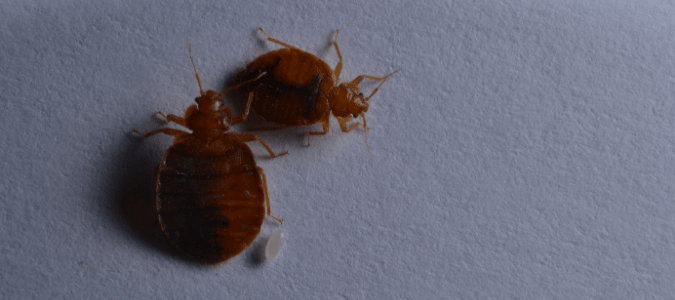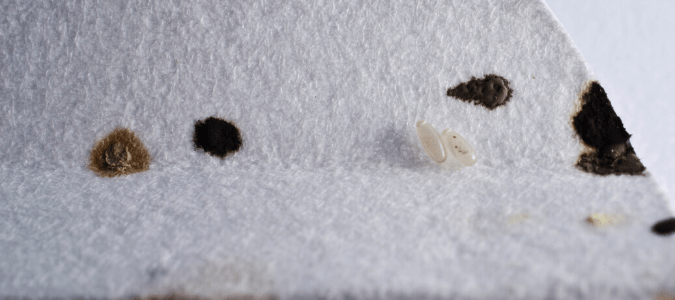
You go to bed one night feeling fine, but wake up the next morning with itchy bites on your skin and disturbing concerns about bed bugs running through your mind. Especially if you’ve recently traveled, you’re wise to wonder about the early signs of bed bugs. Bed bugs hitchhike from one home to another—and even one city to another—by stowing away in luggage, or hiding out in blankets and quilts or in the crevices of used furniture. Fortunately, if you know what bed bugs look like and what some common signs of a bed bug infestation are, you can make a treatment plan so you won’t have to worry about the significant emotional toll that a bed bug infestation can have on your household.
Bed bugs are small, six-legged insects about the size and color of an apple seed, except flatter. They are so flat, in fact, that they can hide in very narrow crevices during the day, when they are less active. They tend to congregate along the piping and seams of mattresses, but may also be found between floorboards, on the wall behind picture frames or around outlet plates, or hidden in the crevices of dresser drawers. These tiny creatures come out at night, under the cover of darkness, to feed on the blood of their sleeping human hosts.
Signs that you are dealing with a bed bug problem include:
- Itchy bites that may show up in the morning. The bites might be found anywhere on the body, but especially on areas of the skin that were exposed overnight. The bites may be pinkish or raised, and they may be randomly spaced or show up close together in a line. This is because bed bugs are known to bite their host, take a blood meal, and then move a centimeter or so away to bite and feed again.
- Small, black specks, dots or streaks on the mattress or pillows. This is bed bug fecal matter.
- Small, rust-colored spots on the mattress, pillows or sheets. These are bloodstains left by the bed bugs after feeding.
- Actual adult bed bugs, whether alive or dead. Adult bed bugs are small, flat and round—just a quarter of an inch across. They have six legs, two antennae and no wings. When they aren’t engorged with blood immediately after feeding, they are medium to dark brown and as flat as a credit card. After feeding, their bodies plump up and darken with blood.
- Bed bug eggs or nymphs. Immature bed bugs look like their adult counterparts except smaller and much paler in color. These differences make them quite a bit harder to see so that they are almost impossible to detect by the untrained eye. Bed bug eggs are smaller still, and very difficult to recognize without the help of a strong light and a magnifying glass.
- Shed skins, which are bed bug exoskeletons that are discarded as these creatures progress through the stages of their life cycle.
Again, bed bugs typically hide deep in whatever surface they are congregating in, so without a thorough inspection, the only sign you may only notice are bites from these pests.
While bed bugs aren’t known to carry or spread diseases, they can still cause health problems for people who are sensitive to their bites. Many people find bed bug bites to be extremely itchy and irritating, which makes it hard not to scratch them. Too much scratching can lead to secondary skin infections. Some people even have allergic reactions to bed bug bites that require medical attention. Bed bugs can also cause sleep and mood problems, since many people find them to be highly undesirable and even anxiety-inducing.
However, bed bugs aren’t the only type of pest that can cause itchy bites. If you wake up with bites and you have pets, it’s possible that fleas are the culprit. In some cases, mosquitoes can also irritate people by biting them in the night. But, since bed bugs are such a serious problem and can be very tough to get rid of, it’s wise to look closely for signs of bed bugs if you have any suspicions of their presence. Also keep in mind that some people can take up to two weeks to start showing signs of bed bug bites, while others don’t react to their bites at all. This means these pests can be growing in numbers for quite some time before anyone in the home realizes there’s a problem.
If you see any of these signs of bed bugs in your bed or elsewhere in your home, it’s important to reach out to a pest specialist right away. Bed bugs are notoriously difficult to control, and heavy infestations might take several weeks or even months of repeated treatments and vigilance to get rid of successfully. People who try to get rid of bed bugs on their own often wind up frustrated when they find their efforts didn’t work and have actually prolonged the situation. Many people prefer to have a professional control the pest problem to ensure that it’s brought under control thoroughly, correctly and as quickly as possible.
If you have experienced one or two of these signs and not the others, you may be wondering if you’re in the clear. The unfortunate truth is that these bugs like to hide out of sight, and can remain hidden away for extended periods of time between feedings. So, you may only experience itchy bites or find rust-colored marks on your pillowcases, but not experience the other signs of bed bugs. If you want further confirmation that the problem is related to bed bugs, you’ll need to learn how to check for bed bugs.

How To Check for Bed Bugs
If you suspect you may have a bed bug problem, it’s important to determine quickly and accurately whether you’re dealing with bed bugs or some other type of pest, so you can address the problem right away before it turns into a full-blown infestation. Here are some important tips on how to check for bed bugs in your bed and the rest of your home:
- Use a flashlight to search for signs of bed bugs along the piping and seams of your mattress and any other furniture where you spend lots of time. Remember, despite their name, bed bugs don’t restrict themselves only to beds. Bed bugs can live in sofas and easy chairs, too—wherever people spend lots of time, especially at night.
- Pull back the sheets or cushion covers to check for black dots or streaks (bed bug feces), rust-colored spots and actual bed bugs. Also, look for shed skins—the exoskeletons that bed bugs leave behind when they molt.
- Use your flashlight to look for bed bugs, their nymphs and their eggs in other hiding spots, such as in the corners of dresser drawers, on the wallpaper next to the bed, under the edge of the rug or even in the cracks between floor boards.
- Remember that searching for bed bugs can be a tedious process, as they may have more than one nesting site. Patience and attention to detail are required, and professional expertise is always helpful in making a positive ID.
The unfortunate truth is that it can be very difficult to get rid of bed bugs on your own, and it’s usually not a straightforward process. You may have to treat for weeks or even months before seeing real progress. This is partly because bed bugs are so adept at hiding. Being as flat as a credit card, they can hide from view in tiny cracks and other spaces. This makes them very difficult to see if you don’t know what you’re looking for. Pest control professionals have the training and experience to spot the definitive signs of bed bugs. Making a conclusive pest identification is an important first step so that targeted pest treatment methods can be implemented.
If you have found bed bugs in your mattress, you may be shocked, worried and frustrated. Fortunately, there are steps you can take in conjunction with a pest management plan that will help to get rid of bed bugs.

How To Get Rid of Bed Bugs in a Mattress
There are several steps you can take to get rid of these pests, but it’s important to know that these measures are most helpful when they’re done as part of a comprehensive treatment plan devised and administered by a pest management specialist. Here is what you can do to get rid of bed bugs in a mattress and throughout other areas of your home:
- Run the hose attachment of your vacuum along the edges of your mattress, making sure to push the piping or seam aside so you can get into the small spaces where bed bugs hide. Then, vacuum the bed frame, the floor and the wall around the bed, since bed bugs can hide in these areas too. Be sure to empty the vacuum’s receptacle thoroughly after each use to dispose of all live bed bugs or eggs. Also, you’ll want to empty the receptacle into a trash bin outdoors, so these pests can’t crawl to another nearby hiding spot inside of your home.
- After vacuuming the mattress, you can use a stiff brush along the seams to dislodge any leftover eggs and then vacuum again.
- Heat can kill off bed bugs. You can wash infected bedding or clothing in hot water and then dry them in a very hot dryer. If it’s very warm and sunny outside, you can seal all potentially infected bedding inside a plastic bag and set it inside a closed, hot car for a couple of days to kill off the bed bugs along with their nymphs and eggs.
- Hot steam can also kill bed bugs if it is set to 130 degrees Fahrenheit or higher and applied to the places where the insects congregate.
- Cold can also kill off bed bugs; put bedding or clothing into the freezer and make sure it’s set at 0 degrees Fahrenheit.
- Another approach is to seal infected items inside a plastic bag and set them aside for a year to ensure that all bed bugs will have been killed off before you open the bag again.
- Similarly, once you have treated your mattress for bed bugs, you might consider purchasing a sealable mattress cover that will kill off any leftover insects or eggs while protecting it from further infestation.
There are “bed bug bomb” products available—aerosol-based insecticide products—but these aren’t a good fit for many people. These fogger-style insecticides work by dispelling a fine mist of bug poison throughout the room. Since bed bugs are typically found in the bedroom, this means using a bed bug bomb will expose anyone who sleeps in the room to chemicals for roughly eight hours a day, which is something most homeowners would prefer t oavoid. Furthermore, bed bugs hide in tiny cracks and crevices, where fogger products often don’t even reach. It’s better to follow the do-it-yourself steps outlined above as part of a total pest treatment plan that is carried out with the help of a reputable and experienced pest control professional.
ABC Can Create a Comprehensive Bed Bug Control Plan
Dealing with a bed bug problem is exhausting and mentally taxing. For a comprehensive, targeted treatment plan, contact ABC Home & Commercial Services. Our highly-trained professionals will be able to locate all of the bed bug hiding spots, and then create a pest control plan that will help you get a better night’s rest.